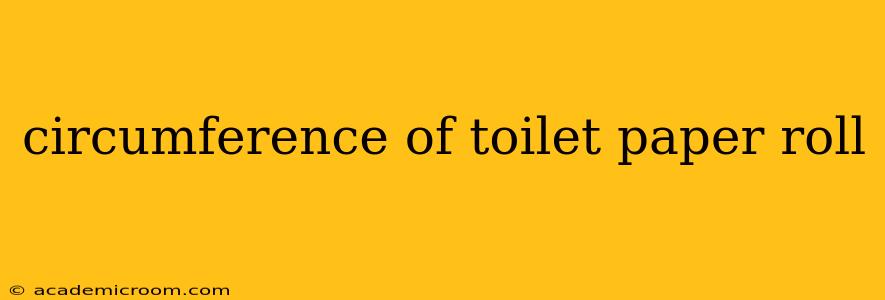The humble toilet paper roll. A seemingly insignificant cylinder, yet its circumference holds a surprising amount of intrigue, particularly for those interested in math, DIY projects, or simply satisfying their curiosity. This comprehensive guide will not only help you calculate the circumference of your toilet paper roll but also explore related concepts and applications.
How to Calculate the Circumference of a Toilet Paper Roll
Calculating the circumference is surprisingly simple, relying on the fundamental formula from geometry: Circumference = 2πr, where 'r' is the radius (half the diameter) of the roll, and π (pi) is approximately 3.14159.
To find the circumference:
-
Measure the diameter: Using a ruler or caliper, carefully measure the diameter of your toilet paper roll. Make sure to measure across the widest part of the roll. Let's say, for example, your measurement is 4 inches.
-
Calculate the radius: Divide the diameter by two to find the radius. In our example, the radius is 2 inches (4 inches / 2 = 2 inches).
-
Apply the formula: Multiply the radius by 2π. Using our example: Circumference = 2 * 3.14159 * 2 inches = approximately 12.57 inches.
Therefore, the circumference of our example toilet paper roll is approximately 12.57 inches.
What is the Average Circumference of a Toilet Paper Roll?
There's no single "average" circumference because toilet paper roll sizes vary slightly by brand and manufacturing. However, the diameters typically range between 3.75 inches and 4.25 inches. This translates to circumferences ranging roughly from 11.8 inches to 13.4 inches.
Why is Knowing the Circumference Useful?
Beyond satisfying mathematical curiosity, understanding the circumference of a toilet paper roll has several practical applications:
-
DIY Projects: Knowing the circumference is crucial for various crafting projects. For example, if you're making a decorative item using the cardboard tube, knowing the circumference helps determine the length of material needed to wrap it.
-
Packaging and Design: In manufacturing and packaging, accurate circumference measurements ensure products fit snugly and efficiently into their containers.
-
Engineering and Design: Even in larger-scale engineering projects, understanding the principles of calculating circumference is fundamental to designing cylindrical components.
How Does the Circumference Change as Toilet Paper is Used?
As you use the toilet paper, the diameter of the roll gradually decreases. Consequently, the circumference also decreases proportionally. This change is continuous and nonlinear—the reduction in circumference is more pronounced initially and slows down as the roll gets smaller.
How to Measure the Circumference Without Measuring the Diameter?
While measuring the diameter is the most straightforward method, you could directly measure the circumference. Wrap a flexible measuring tape around the roll and read the measurement directly. This method, while simple, might be slightly less precise than using the diameter and formula.
What is the Relationship Between Diameter and Circumference?
The relationship between diameter and circumference is directly proportional; meaning if you double the diameter, you double the circumference, and vice versa. This is because the circumference is always π times the diameter (Circumference = πd).
This guide provides a comprehensive understanding of how to calculate and understand the circumference of a toilet paper roll, extending beyond a simple calculation to explore practical applications and related geometric principles. Remember that slight variations in measurements are normal due to manufacturing tolerances.
